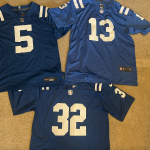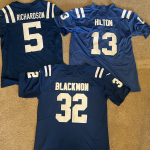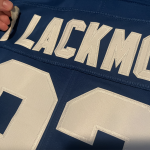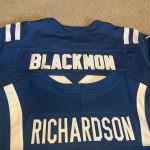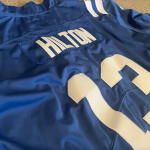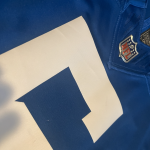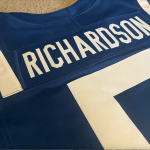2 Interception: Examining the industry of counterfeit NFL jerseys
Patrick Felts
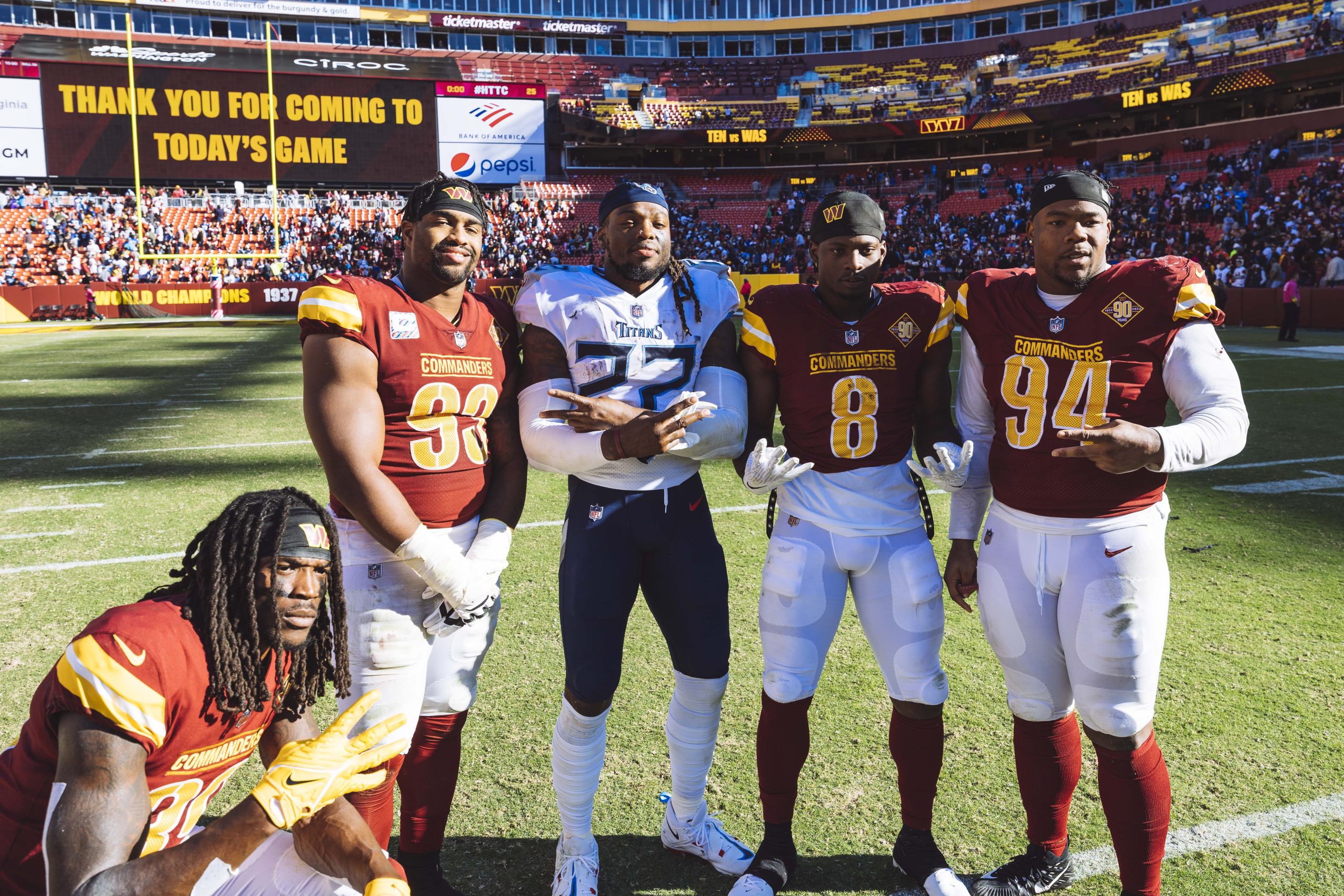
Products from top brands are more expensive than ever.
With the recent rise in inflation as well as the economic challenges of the 2020s caused by the COVID-19 pandemic and more, Americans are spending more than ever before. With things so expensive, many have sought alternatives to these pricey goods.
Enter the counterfeit industry, worth nearly an estimated $2 trillion annually and is fast-rising, according to research at North Carolina State University (Handfield). Due to the illicit nature of this business, its true economic impact can be difficult to accurately measure.
The counterfeit industry is worth an estimated $2 trillion annually and
is fast-risingWhile the production and distribution of counterfeit goods is not legal, a stroll down Canal Street in New York City or Las Vegas Boulevard in Paradise, Nevada, will suggest otherwise. Everything from designer bags to shoes and even electronics are found at prices that are too good to be true from street vendors all across the world.
Today, counterfeit vendors can still be found on street corners in major global cities, but they have also moved into the digital space. Websites such as DHGate, AliExpress, and other websites that sell counterfeit goods operate similarly to a website like eBay rather than a traditional retailer. Goods on these sites are sold by individual sellers rather than the sites themselves, which means that the sellers set their own prices, shipping rates, and more, and the website itself acts as a middleman.
In the United States and around the world, one of the most prevalent counterfeit items are knockoff sports jerseys. In the United States, these are largely NFL jerseys, the most popular sport in the country and the most profitable sporting organization on earth.
While thousands of NFL fans purchase knockoff jerseys every year, many of them have no idea where they come from, how they are produced, what it takes to get to their front door, and the difference in quality between the authentic jersey and the cheap alternative.
The Game Plan: How DHGate and Similar Sites Operate
NFL jerseys are incredibly expensive. For an article of clothing that most fans will only wear during the 17 Sundays in the fall that their favorite team is playing, the price of an authentic jersey is quite high.
According to a CNN article published in 2012, the going rate for an authentic NFL jersey was in excess of $80, while knockoffs sold for about $30. Just over a decade later, this both is and is not the case. On the NFL Shop website, the price of the least expensive model of the official Nike jerseys, the “Game” line, costs $130 today. The more premium models, Nike’s “Vapor F.U.S.E. Limited” and “Vapor Elite,” retail for $175 and $350, respectively. Meanwhile, on a site that sells counterfeit jerseys such as DHGate, the $30 going rate has gone down since 2012, with these fake NFL jerseys routinely selling for $20 or less and shipping for free (Dickler).
Free shipping is rampantly advertised on DHGate and similar sites, which seems peculiar due to the already cheap costs of the items and the immense distance between the largely Chinese producers and North American and Western European consumers. The listed shipping dates are often misleading, as even when sorting exclusively by products that ship for free on the DHGate app, there will be no option for free shipping.
For years, the shipping truly was free from most of these vendors, but since 2018, free shipping from China has become more and more difficult to come by. That year, President Trump withdrew from a then-144-year-old postal treaty which he claimed gave Chinese vendors an unfair advantage in the digital commerce market due to USPS subsidies. Although typically no longer free, shipping from China via ePacket — an ecommerce shipping method created through an agreement between USPS and China Post — is still very cheap compared to other international or even domestic shipping services (Choi).
The tradeoff with this free or cheap international shipping is long wait times. While the shipping times advertised by these sellers are usually around one month or less, they can often take two or three months to arrive at the buyer’s front door.
A friend of mine ordered a Barry Sanders Detroit Lions jersey and a Clark Griswold Chicago Blackhawks jersey on Nov. 1, 2023. He made these purchases in anticipation of the winter holidays, as the Lions play on Thanksgiving every year and Griswold is his favorite character in the Christmas film National Lampoon’s Christmas Vacation. According to the DHGate listings, the jerseys would arrive before these holidays on Nov. 13 and Nov. 16, respectively, but the jerseys did not arrive by this date. A delay notification came to him in the app about a week after he made the order, and both jerseys are now expected to arrive in early January 2024.While the shipping times advertised by these sellers are usually around one month or less, they can often take two or three months to arrive at the buyer’s front door
While it can take forever for these items to ship, finding the jerseys on a site like DHGate takes minimal effort – although it is still slightly unusual. You will not find many jerseys by searching by the name of your favorite team on a knockoff site. Instead, every product name only includes the names of the players whose jersey you can buy on the individual listing.
The listings are also typically devoid of any actual pictures of the product that is actually being sold, instead showing a stock image of the jersey ripped from the NFL Shop website, with all copyrighted materials such as the NFL shield, team logos, and Nike logos removed from the image for what can only be assumed to be legal purposes. Even without these copyrighted materials shown in the image listing, every jersey shipped will always include these on the actual product.
Crossing the Goal Line: How Counterfeit Jerseys Get to the United States
The sale and production of counterfeit jerseys is not legal in the United States, although federal law does not prohibit the purchase of these goods for consumers. In addition, because these websites and sellers are not based in the United States, it is incredibly difficult to cease the stream of counterfeit goods into the country.
While U.S. Immigration and Customs Enforcement and other federal agencies claim to make major busts on counterfeit jerseys annually, such as “Operation Interception” during the 2012 Super Bowl in Indianapolis, in which ICE seized $3.56 million in counterfeit NFL merchandise, many counterfeit items shipped from vendors in China to consumers in the US make it through the cracks (ICE) (Dickler).
According to Reddit user /u/Hermesflexer on the /r/JerseyReps forum, which is dedicated to discussion of buying jerseys from “reps,” a nickname for counterfeit vendors, package seizures are a non-factor when buying a knockoff jersey online.
“Seizing packages are random. Here in the U.S it is pretty chill as long as it isn’t 3kgs of designer brands,” the user wrote. “I order reps regularly not just jerseys but I have ordered reps for the past 2 years and I never got seized. You will be fine.”
After talking with several friends, relatives, and classmates who have previously purchased counterfeit jerseys, none of them has ever had an issue with US customs intercepting their package and seizing the goods.
“To the untrained eye, it can be difficult to distinguish between a knockoff jersey and the real thing,” Jack Ma, founder and chairman of AliBaba, which owns AliExpress, said “The problem is the fake products today are of better quality and better price than the real names. They are made in exactly the same factories, with exactly the same raw materials [as authentic goods], but they do not use the names.” (“Nowadays”)
Of course, many of the products sold on his site and many others do, in fact, use the names of the companies which he claims that the sellers on his platform and other share factories with, but Ma makes a point to mention the quality of an AliExpress product, particularly in comparison with the real thing.
“To the untrained eye, it can be difficult to distinguish between a knockoff jersey and the real thing,”The prices are far lower and the factories and materials are allegedly the same – but how does the quality of products sold by these vendors compare to the real thing?
Challenge Flag: Comparing the Quality of Authentic and Counterfeit Jerseys
After what could be either a few weeks or a few months of waiting, the jersey you ordered has finally shipped from the factory where it was made alongside the legitimate NFL jerseys to your front door.
This raises the ultimate question: how does the quality of these jerseys compare to the real thing, and is the price difference worth it?
For a quality comparison, we will use three jerseys of the same team, the Indianapolis Colts. One of the jerseys is a legitimate Nike F.U.S.E Limited Anthony Richardson jersey, purchased from the NFL Shop in 2023. The other two, a T.Y. Hilton jersey and Julian Blackmon jersey, were purchased from DHGate in 2018 and 2020, respectively. The two knockoff jerseys were borrowed from a friend for this comparison.
The material is noticeably different on the knockoff jersey compared to the legitimate one. While they both have a similarly soft feel to the touch, the counterfeit jersey is far less stretchy than the official jersey. The official jersey is made from an athletic material that is both more resilient to pulls and stretches and also wicks away sweat.
- The front of all three jerseys examined for the comparison. Anthony Richardson (5) is an authentic, while T.Y. Hilton (13) and Julian Blackmon (32) are not. (Photo by author)
- The back of all three jerseys examined for the comparison. Anthony Richardson (5) is an authentic, while T.Y. Hilton (13) and Julian Blackmon (32) are not. (Photo by author)
- Comparing the sleeves of all three jerseys. Notice the blockiness of the font on the Blackmon jersey and difference in color on the Hilton jersey. (Photo by author)
The names and numbers on the jerseys are different as well. On the Nike Vapor F.U.S.E Limited jersey, the name and number are heat pressed onto the jersey and are nearly impossible to fade or fall off. On the knockoffs, this is not the case. The Hilton jersey features a name and numbers that are sewn into the jersey, but the sewing job is shoddy and features many loose strings. It feels like it is one loose string catching a door hinge away from falling apart. The Blackmon jersey gives the illusion of properly sewn numbers with no loose threads, but a closer look shows that the name is actually glued on, letter by letter. The letter “B” on the jersey is falling off.
The legitimate Nike jersey has an athletic fit to it – snug and tight. The knockoffs both have a baggier fit to them, best illustrated in the way they fit in the armpits. The Hilton jersey’s biggest flaw in the way it fits is in the collar, which is loose and sticks up vertically on the side and back of the neck – this is not the case on the legitimate jersey or the Blackmon jersey, where the collar lies flat.
- The “B” in Blackmon is falling off this jersey. While the stitching gives the illusion of it being sewed, it is actually glued on. (Photo by author)
- Notice the difference in color and quality of material between the Richardson jersey and the Hilton jersey. (Photo by author)
- The most noticeable differences on the back of these jerseys are the size of the shoulder stripes, fonts and materials used on the nameplates, and distance between the nameplates and collars. (Photo by author)
The details on the counterfeit jerseys are lacking compared to the legitimate ones. The official Nike jersey has every detail that the Colts wear on their actual uniforms, from the proper Nike swoosh to the “C” logo on the inside of the collar. Neither of the knockoffs are as precise in their details, but in different ways.
The Hilton jersey is noticeably incorrect when compared to an official jersey at one glance, simply due to its color. The color of this jersey is several hues too light compared to any shade of blue that the Colts have ever worn before, immediately distinguishing it as fake when spotted in a sea of other Colts jerseys at a game or a crowded sports bar. The Nike swooshes on the sleeves are puffier than the actual Nike logo, and this jersey features a noticeable convergence of three seams in a triangle-like pattern on its back.
- The back side of the Hilton jersey in full view. (Photo by author)
- The front of the Richardson jersey. (Photo by author)
- The back side of the Richardson jersey. Its attention to detail in comparison with the others is stark. (Photo by author)
The Blackmon jersey is a far more accurate recreation prior to further examination, simply because it gets the color right. Beyond its color, this jersey also includes other details such as the “C” logo inside the collar, but misses the mark in other ways. This jersey also includes the three seams on the back also seen on the Hilton jersey, but on this jersey, the name and number on the back also sit far lower than on an official jersey. The “32” on the front and back is far smaller than on an official jersey.
Perhaps most noticeable is the difference in fonts between this jersey and a legitimate one from the same time. In 2020, the Colts changed the font on their jersey numbers from a standard block font to a more rounded typeface, as seen on the legitimate Anthony Richardson jersey. Julian Blackmon, the player featured on this jersey, joined the team in 2020 after this change was made, making the block number font seen on this jersey immediately inaccurate. T.Y. Hilton played for the Colts from 2012-21, making the jersey number font accurate on his jersey.
Final Score
The difference between authentic and knockoff jerseys is stark. The quality of materials used and attention to detail are not on par with one another. Simple details like the correct shade of blue or font that the knockoffs do not get correct is the $100 difference between the fake and the real thing.
But, the counterfeit jersey market is lucrative for a reason. Not everybody has $150 to spend on an article of clothing that they will wear infrequently for a player who could be traded at any moment. Spending just $20 or $30 on something that would typically cost five times as much is enticing, if you’re willing to wait for weeks or months for it to ship and to buy an unlicensed product.
In sports, teams who do the little things right tend to be the most successful – and counterfeit jerseys miss on these small, but crucial, details.
References
Choi, M. (2018, October 17). Trump withdraws from postal treaty in new front against China. POLITICO. https://www.politico.com/story/2018/10/17/trump-withdraws-from-postal-treaty-910675
Dickler, J. (2012, January 25). Feds crack down on counterfeit Super Bowl gear. CNNMoney. https://money.cnn.com/2012/01/25/pf/counterfeit_super_bowl/index.htm
Handfield, R. (2021, September 29). Counterfeiting is on the rise, and projected to exceed $3 trillion in 2022 | SCM | supply chain resource cooperative (SCRC) | north carolina state university. Supply Chain Resource Cooperative. https://scm.ncsu.edu/scm-articles/article/counterfeiting-is-on-the-rise-projected-to-exceed-3-trillion-in-2022
ICE, CBP, USPIS seize more than $13.6 million in fake NFL merchandise during “Operation Red Zone.” (n.d.). Www.ice.gov. https://www.ice.gov/news/releases/ice-cbp-uspis-seize-more-136-million-fake-nfl-merchandise-during-operation-red-zone
Nowadays, Counterfeit Goods are “Almost Identical” to the Real Thing. (2018, May 24). The Fashion Law. https://www.thefashionlaw.com/counterfeit-goods-are-almost-identical-the-the-real-thing/

